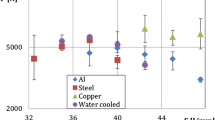Abstract
Dissimilar joining of thin (∼1 mm) 6111-T4 aluminium alloy and DC04 uncoated low carbon steel used in automobile structures was carried out using laser spot joining in conduction mode. Two sets of experiments were carried out, using copper and aluminium backing bars, respectively. The welds were produced in overlap configuration with steel on the top. The steel surface was irradiated by the laser, and the heat was conducted through the steel into the aluminium. Temperature at the interface was controlled using the fundamental laser energy parameters so that aluminium melts and wets the steel surface. Reaction between the two metallic alloys resulted in the formation of intermetallic compounds (IMC). The formation pattern of IMC was dependent on the temperature profile and the distribution across the interface and was thicker in the centre of the weld and thinner near the edges. The stoichiometry of the IMC formed was varied across the layer and was principally composed of two different layers of Fe2Al5 and FeAl3. Micro hardness tests were carried out to characterise the IMC layer. Mechanical shear tensile tests showed a maximum joint shear strength of up to 68 % of the shear strength of the aluminium alloy.
Similar content being viewed by others
References
H.M. Government (2009) The UK Low Carbon Five point plan. 220
Okamoto H (2010) Desk Handbook: Phase Diagrams for Binary Alloys. 855
Acarer M, Demir B (2008) An investigation of mechanical and metallurgical properties of explosive welded aluminum–dual phase steel. Mater Lett 62:4158–4160. doi:10.1016/j.matlet.2008.05.060
Lee K-J, Kumai S, Arai T, Aizawa T (2007) Interfacial microstructure and strength of steel/aluminum alloy lap joint fabricated by magnetic pressure seam welding. Mater Sci Eng A 471:95–101. doi:10.1016/j.msea.2007.04.033
Tanaka T, Morishige T, Hirata T (2009) Comprehensive analysis of joint strength for dissimilar friction stir welds of mild steel to aluminum alloys. Scr Mater 61:756–759. doi:10.1016/j.scriptamat.2009.06.022
Uzun H, Dalle Donne C, Argagnotto A et al (2005) Friction stir welding of dissimilar Al 6013-T4 To X5CrNi18-10 stainless steel. Mater Des 26:41–46. doi:10.1016/j.matdes.2004.04.002
Song JL, Lin SB, Yang CL, Fan CL (2009) Effects of Si additions on intermetallic compound layer of aluminum–steel TIG welding–brazing joint. J Alloys Compd 488:217–222. doi:10.1016/j.jallcom.2009.08.084
Lin SB, Song JL, Yang CL, Ma GC (2009) Metallurgical and mechanical investigations of aluminium-steel butt joint made by tungsten inert gas welding–brazing. Sci Technol Weld Join 14:636–639. doi:10.1179/136217109X12464549883493
Jácome LA, Weber S, Leitner A et al (2009) Influence of Filler Composition on the Microstructure and Mechanical Properties of Steel-Aluminum Joints Produced by Metal Arc Joining. Adv Eng Mater 11:350–358. doi:10.1002/adem.200800319
Murakami T, Nakata K, Tong H, Ushio M (2003) Dissimilar Metal Joining of Aluminum to Steel by MIG Arc Brazing Using Flux Cored Wire. ISIJ Int 43:1596–1602. doi:10.2355/isijinternational.43.1596
Sasabe S, Iwase T, Matsumoto T et al (2009) Dissimilar Metal Joining of Aluminum Alloys to Steel in MIG Braze Welding by using the advanced Hot-dip Aluminized Steel Sheet. Q J Japan Weld Soc 27:55s–59s. doi:10.2207/qjjws.27.55s
Mathieu A, Shabadi R, Deschamps A et al (2007) Dissimilar material joining using laser (aluminum to steel using zinc-based filler wire). Opt Laser Technol 39:652–661. doi:10.1016/j.optlastec.2005.08.014
Laukant H, Wallmann C, Müller M et al (2005) Fluxless laser beam joining of aluminium with zinc coated steel. Sci Technol Weld Join 10:219–226. doi:10.1179/174329305X37051
Yan S, Hong Z, Watanabe T, Jingguo T (2010) CW/PW dual-beam YAG laser welding of steel/aluminum alloy sheets. Opt Lasers Eng 48:732–736. doi:10.1016/j.optlaseng.2010.03.015
Takemoto T, Kimura S, Kawahito Y et al (2009) Fluxless joining of aluminium alloy to steel by laser irradiation method. Weld Int 23:316–322. doi:10.1080/09507110802542643
Oikawa H, Ohmiya S, Yoshimura T, Saitoh T (1999) Resistance spot welding of steel and aluminium sheet using insert metal sheet. Sci Technol Weld Join 4:80–88. doi:10.1179/136217199101537608
Qiu R, Iwamoto C, Satonaka S (2009) The influence of reaction layer on the strength of aluminum/steel joint welded by resistance spot welding. Mater Charact 60:156–159. doi:10.1016/j.matchar.2008.07.005
Qiu R, Satonaka S, Iwamoto C (2009) Effect of interfacial reaction layer continuity on the tensile strength of resistance spot welded joints between aluminum alloy and steels. Mater Des 30:3686–3689. doi:10.1016/j.matdes.2009.02.012
Liyanage T, Kilbourne J, Gerlich AP, North TH (2009) Joint formation in dissimilar Al alloy/steel and Mg alloy/steel friction stir spot welds. Sci Technol Weld Join 14:500–508. doi:10.1179/136217109X456960
Assuncao E, Williams S, Yapp D (2012) Interaction time and beam diameter effects on the conduction mode limit. Opt Lasers Eng 50:823–828. doi:10.1016/j.optlaseng.2012.02.001
Assuncao E, Williams S (2013) Comparison of continuous wave and pulsed wave laser welding effects. Opt Lasers Eng 51:674–680. doi:10.1016/j.optlaseng.2013.01.007
Qiu R, Iwamoto C, Satonaka S (2009) Interfacial microstructure and strength of steel/aluminum alloy joints welded by resistance spot welding with cover Plate. J Mater Process Technol 209:4186–4193. doi:10.1016/j.jmatprotec.2008.11.003
Kobayashi S, Yakou T (2002) Control of intermetallic compound layers at interface between steel and aluminum by diffusion-treatment. Mater Sci Eng A 338:44–53. doi:10.1016/S0921-5093(02)00053-9
Sepld G, Kreimeyer M (2003) Joining of Dissimilar Materials. SPIE Int Symp High-Power Laser 4831:526–533
Author information
Authors and Affiliations
Corresponding author
Rights and permissions
About this article
Cite this article
Pardal, G., Meco, S., Ganguly, S. et al. Dissimilar metal laser spot joining of steel to aluminium in conduction mode. Int J Adv Manuf Technol 73, 365–373 (2014). https://doi.org/10.1007/s00170-014-5802-y
Received:
Accepted:
Published:
Issue Date:
DOI: https://doi.org/10.1007/s00170-014-5802-y




